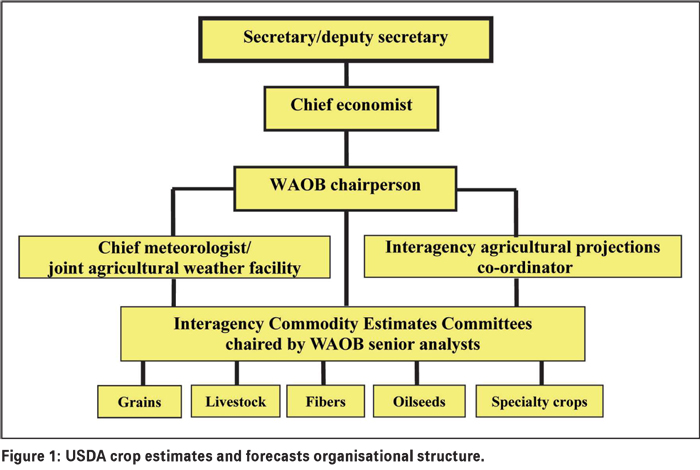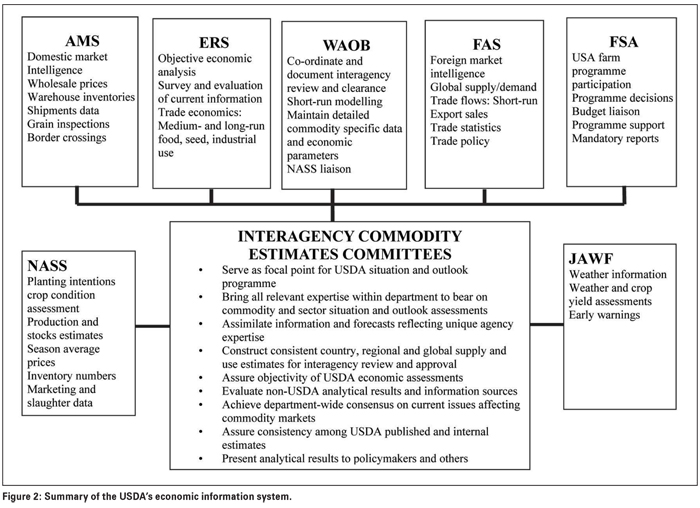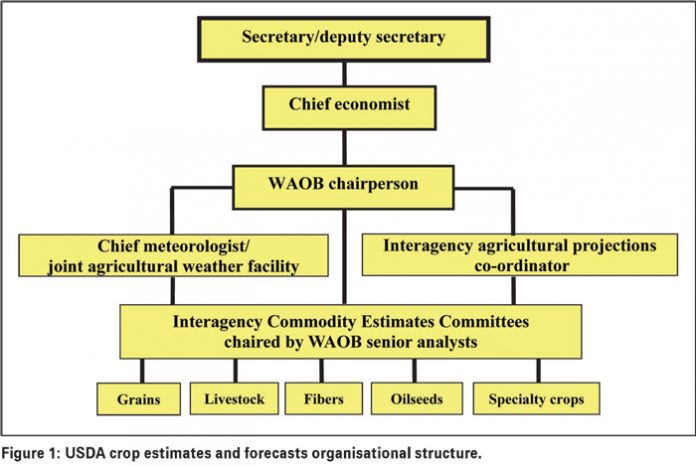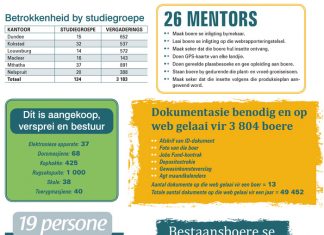January 2018
DR DIRK ESTERHUIZEN, senior agricultural specialist, USDA – Foreign Agricultural Service, USA Embassy, Pretoria
Each month, the United States Department of Agriculture (USDA) publishes crop supply and demand estimates for the United States of America (USA) and the world in the World Agricultural Supply and Demand Estimates (WASDE) report.
These estimates are used as benchmarks in the marketplace because of their comprehensive nature, objectivity, and timeliness. The statistics that USDA releases affect decisions made by producers, businesses, and governments, by defining the fundamental conditions in commodity markets worldwide. However, when using USDA statistics and especially crop estimates and forecasts, it is helpful to understand the role of the different institutions involved, the methodology and the process.
How WASDE reports are prepared
The role of the WAOB
The World Agricultural Outlook Board (WAOB) is a unit of the Office of the Chief Economist (OCE) of USDA (see also Figure 1). OCE advises the Secretary of Agriculture on the economic implications of policies and programmes affecting the USA food and fibre system and rural areas.

The WAOB was created in 1977 to serve as the focal point for economic intelligence on the outlook for USA and world agriculture. Prior to 1977, responsibility for USDA’s food and fibre outlook information was fragmented among several agencies.
While these agencies’ missions did not change, the board was created to co-ordinate USDA’s outlook analysis and assure its accuracy, timeliness and objectivity. The board co-ordinates, reviews, and approves the monthly WASDE report.
WAOB’s senior commodity analysts also chair the monthly Interagency Commodity Estimates Committees (ICEC) meetings. The board also houses OCE’s Joint Agricultural Weather Facility (JAWF).
JAWF monitors global weather and assesses its impact on foreign crop conditions and potential yields.
The role of the ICEC
A consensus or ‘interagency’ approach is used to arrive at supply and demand estimates. The monthly ICEC meetings are comprised of representatives from several key USDA agencies. These agencies include:
- The National Agricultural Statistics Service (NASS) which estimates and forecasts USA crop production based on data collected from farm operations and field observations.
- The Foreign Agricultural Services (FAS) which provides information regarding foreign production, use and trade. FAS gather global market intelligence from its network of agricultural attachés. This information is assembled and reviewed in FAS headquarters by commodity and trade analysts and circulated to all participants in the interagency process. Satellite imagery is interpreted to assess foreign crop production potential.
- The Economic Research Services (ERS) identifies the most important economic effects and implications for prices, quantity supplied and quantity demanded. This may include information on such diverse factors as exchange rates, oil prices, the effects of domestic and foreign agricultural policy, and economic growth. ERS analysts routinely interact with analysts in the FAS.
- The Farm Service Agency (FSA) describes the current policy environment and particularly how producers likely will react to current legislation. FSA employs econometric models, tempered by specialist expertise. This activity involves considerable interaction with ERS.
- The Agricultural Marketing Service (AMS) provides current price and marketing reports for crops and livestock. AMS marketing specialists monitor markets in action on a daily basis and share observations with USDA analysts department-wide.
This broad information base is reviewed and analysed by ICEC members who bring diverse expertise and perspectives to the report. To arrive at consensus forecasts, alternative assessments of domestic and foreign supply and use are vetted at the ICEC meetings.
Throughout the growing season and afterwards, estimates are compared with new information on production and utilisation, and historical revisions are made as necessary.
The commodity balance sheets
The WASDE reports reflect a full balance sheet for each commodity and country. This broad commodity coverage allows analysts to reconcile changes among commodity balance sheets. For example, in order to estimate world soybean supply and demand, separate balances are prepared for 90 countries.
Separate estimates are made for beginning stocks, imports and prospective production to determine the total supply of a crop that will be available for the new marketing year. The demand side of the balance sheet reflects domestic use, exports and ending stocks. Domestic use may be further subdivided to the extent that such data are available from other sources.
The balance sheet disciplines individual estimates as such that total supply must always equal domestic use plus exports and ending stocks. Prices tie both sides of the balance sheet together by rationing available supplies between competing uses. Prices also shape planting decisions for the out-year, providing a link between current and future years.
The process of forecasting price and balance sheet items is a complex one involving the interaction of expert judgment, commodity models, and in-depth research by department analysts on key domestic and international issues. This process plays out each month in ICEC.
Critical supply and demand relationships change over time as policies and structure change. A quality departmental forecasting process requires a strong research programme to ensure that understanding of markets keeps up with changing conditions.
USDA analysts are responsible for keeping the department’s information base and models abreast of changing market relationships. Research conducted by ERS is a critical part of the process of maintaining the quality and objectivity of departmental supply, demand and price estimates.
The forecasting cycle
Supply and demand estimates are forecast on a marketing-year basis. The marketing year for each crop usually begins with the first month of harvesting, and thus can differ by country or region for the same crop. USDA’s marketing year designation for a country may differ from the one used locally – especially where crops such as rice are harvested year round.
Aggregate world supply and demand estimates represent the summation of numerous local marketing years that stretch across many months. For a given year, aggregate world supply and demand estimates represent a concept and not a world total at one point in time. For example, the 2017/2018 marketing year (MY) for USA corn begins on 1 September 2017 and ends 31 August 2018.
The WASDE report also includes a forecast for the 2017/2018 production season’s corn supply and use for South Africa, where harvest begins in May 2018 and the marketing year ends in April 2019. Since the 2018/2019 MY South African crop will compete with the USA 2017/2018 MY crop in world corn markets, USDA includes the 2018/2019 MY South African corn crop in the WASDE report under the 2017/2018 MY world totals.
The forecasting cycle for the new marketing year begins with projections in the May WASDE report. NASS publishes its first estimate of USA winter wheat production in May and spring wheat and other small grains production in July.
For spring-planted crops, most notably corn, soybeans and cotton, May, June, and July projections of USA crop production in the WASDE report are based on trend yields and NASS estimates of intended and planted acreage. The assumptions used are spelled out in the footnotes of each table. For both USA and foreign estimates, normal weather is assumed for the balance of the growing season. These early-season projections, for both the USA and the world, while necessarily highly tentative, provide a preliminary look at crop supplies and market conditions.
Lockup conditions
To assure the highly market-sensitive information is released simultaneously to all end-users, and not prematurely to any one, the WASDE report is prepared under tight security in a specially designed area of USDA’s South Building.
The morning of release, doors in the ‘lockup’ area are secured, window shades are sealed, and telephone and internet communications are blocked. Once analysts present their credentials to a guard, they enter the secured area to finalise the WASDE report.
Communications with the outside world are suspended until the report is released at 12:00 noon Eastern Time.
Summary
The value of USDA statistics to data users depends on the ease, speed, and cost of access. As a result, the USDA’s Economic Information System strives for three goals (Figure 2 summarises the USDA’s economic information system):

Objectivity
Production numbers are discussed separate from trade numbers. Foreign production is discussed separate from USA production. The Secretary of Agriculture officially releases numbers but has no input in the numbers.
Reliability
Best available data and analysis are used; however, agriculture is strongly driven by weather and is changeable. USDA acknowledges this and will update numbers next month with new data.
Timeliness
Data and information are crucial for the commercial market’s decision-makers. Internet, agricultural radio, news wires, fax list and paper copies are used to broadcast information. Release dates and time of release are carefully choreographed. That is the essence of the lockup process.
The latest reports and other helpful information on NASS crop and livestock estimates can be found at https://www.nass.usda.gov/.
WAOB information on supply and demand estimates and agricultural weather is located at https://www.usda.gov/oce/commodity/index.htm
The latest attaché reports can be viewed at https://www.fas.usda.gov/data
Publication: January 2018
Section: On farm level


















